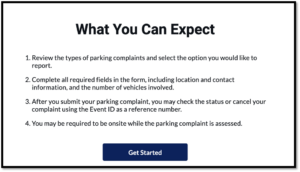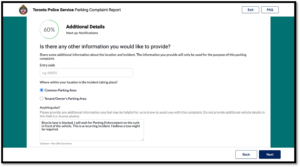Written by: Patrick Brown, Principal Partner and Jamie Davison, Student-At-Law
Parking a vehicle in a bicycle lane is extremely dangerous, not to mention inconsiderate. The City of Toronto has attempted to prevent people from blocking cycling infrastructure with their vehicles by passing by-laws which regulate the safe use of cycling infrastructure throughout the city. In this blog, we aim to provide Torontonians with multiple ways to report and address incidents of vehicles blocking cycling infrastructure in the hopes of deterring this inconsiderate, foolish, and extremely dangerous act.
Understand the Bicycle Lane Regulations:
The Toronto Municipal Code specifies the rules for cycle tracks and bicycle lanes to ensure the safety of cyclists and pedestrians. Specifically, Chapter 886-15 and 886-10 are relevant to this issue:
- Chapter 886-15 of the Toronto Municipal Code – Stopping in a cycle track
This provision outlines the operation, stopping, and exemptions for drivers relating to cycle tracks. No person shall operate or stop a vehicle other than a bicycle in any cycle track except for the purpose of:
- Moving into or leaving a private lane or driveway adjacent to the bicycle lane.
- Loading or unloading of persons with a disability from a Wheel-Trans vehicle, operated by or under contract to TTC, while actively engaged in doing so.
Exemptions
- Ambulances, police or fire service vehicles or any other vehicle actively engaged in responding to an emergency.
- Vehicles actually and actively engaged in works undertaken for or on behalf of:
- A public utility, including utilities providing telecommunications, energy, water supply or wastewater related services.
- Chapter 886-10 of the Toronto Municipal Code – Stopping in a Bicycle Lane
This provision outlines the operation, stopping, and exemptions for drivers relating to bicycle lanes. No person shall operate a vehicle other than a bicycle in any bicycle lane except for the purpose of:
- Moving into or leaving a private lane or driveway adjacent to the bicycle lane.
- Making a turn at a highway intersecting the bicycle lane.
- Entering or exiting a curb lane used for parking.
- Loading or unloading of a person with a disability, while actively engaged in doing so.
- Operating a school bus while actively engaged in picking up or dropping off school children.
- Operating a taxicab while actively engaged in loading or unloading of passengers.
Subject to subsections 4, 5, and 6, no person shall stop a vehicle in a bicycle lane.
Exemptions
- Ambulances, police or fire service vehicles or any other vehicle actively engaged in responding to an emergency.
- Vehicles actually and actively engaged in works undertaken for or on behalf of:
- The City, The TTC, or a public transit agency authorized to operate in the City.
- A public utility, including utilities providing telecommunications, energy, water supply or wastewater related services.
Reporting Violations
The Toronto Police have an online reporting system where you can request a Parking Enforcement Officer respond to a parking issue that is currently occurring. Imagine you bike to work each day. Since traffic in Toronto can get so busy during rush hour, on your route to work, you prefer to stick to travelling in bicycle lanes. However, for the past couple of weeks there has been a delivery truck parked in front of a pizza shop every Tuesday and Thursday that completely blocks the bike lane. Your only option to get around the truck is to ride your bike onto the sidewalk, around the truck, and back into the bike lane. One option for dealing with this hazard is to file an online report. Below, we have included screen captures of the prompts you will be presented with when completing this report.
Click on “Create a Report”
Users will then be prompted with this page where they are informed as to what the reporting process will entail. Click “Get Started”.
At the initial intake, the user chooses what type of complaint they would like to make. In this case you would click “A public laneway is blocked” and then “Next”.
At this stage you must describe the location of the incident, you will choose “On Street” and input the related address. Then click “Next”.
Next, you describe the make, model, and license plate (if you remember it or have a photo of it) of the vehicle that is blocking the lane. Then click “Next”.
For the purposes of having an officer contact you for further information, you are asked to provide your contact details. What isn’t shown in this screen capture is the option to include your phone number as well. Then click “Next”.
At this stage you describe the incident. Be as specific as possible and detail where the officer can find you upon their arrival at the scene. Then click “Next”.
At this second last stage, you get to choose how you would like to receive updates on your report, either via email or text. Double check to ensure the information you have included is correct. Click “Next”.
Lastly, you review the information you have provided. While the blue box seems intimidating, with the specific context of a vehicle blocking a cycling track or bicycle lane, those are considered public property and thus having the property owner’s support is not required. However, in other scenarios, if the vehicle is on private property, and you wish to have it towed or tagged, you will require the owner of the property to be present with documentation speaking to their ownership.
Alternative Reporting Options:
The City of Toronto invites cyclists and pedestrians to report incidents to their reporting centre in person at the Traffic Services Unit, station at 9 Hanna Avenue in Liberty Village. It is operated by Accident Support Services International and available from 11 a.m. to 7 p.m. Monday to Friday (excluding holidays).
Contacting the Police:
In urgent cases, or when other reporting methods do not yield results, individuals can call the Police Non-Emergency line at 416-808-2222 to report the violation. To achieve the best results, it is crucial that at this point that you provide clear evidence of the incident. If this is a recurring problem, provide photos to demonstrate the multiple times that the vehicle has been parked in the bicycle lane or cycling track to support your case. Further, if you are not the owner of the property in front of which the vehicle is parked, speaking with and getting the support of the owner could also benefit your case.
Penalties:
The fine for parking in a bicycle lane is $150. Once fined, they will receive a Notice of Fine and Due Date by the City. If drivers fail to pay these fines, under the Provincial Offences Act, Toronto is responsible for enforcing and collecting these fines. Serious legal consequences may result if individuals fail to pay their fines on time; these consequences can include:
- The suspension of their driver’s licence (with a fee for reinstatement).
- An order issued requiring their employer to withhold portions of their wages which are sent directly to the City until their debt is fully paid.
- An order issued to seize and sell their property to pay off the debt (including real estate, cars, and personal property).
- The addition of their fines to the tax roll of real property they own.
- An order for their bank to pay the debts directly from their bank account.
- A freeze on renewing their licence plate sticker.
- A lowered credit score.
- Formal collection via Private Collection Agency.
- The exposure to additional fees, costs, interest, and sub-charges.
Advocacy:
Here at McLeish Orlando, we help numerous clients every year who are injured while cycling. We are extremely grateful for the efforts taken by the City of Toronto in support of bike safety, and encourage readers to engage with local authorities and officials to take advantage of these enforcement mechanisms in reporting these incidents. Doing so is beneficial not only for your personal safety as a cyclist or pedestrian, but also will lead to a safer environment for all cycling infrastructure users. We invite you to take action and report violations when you encounter them; community advocacy can lead to better enforcement of regulations and create a safer Toronto for cyclists.














